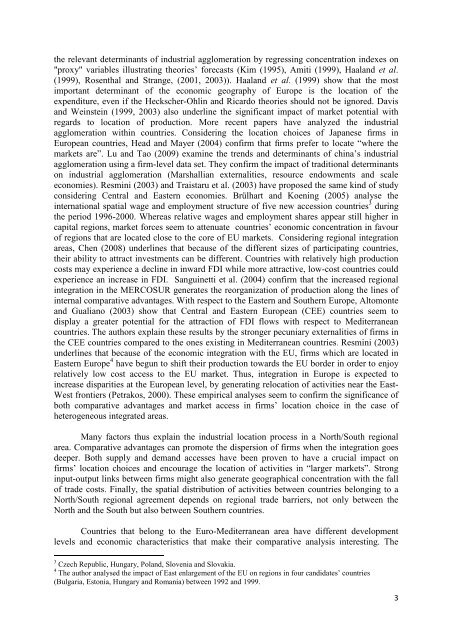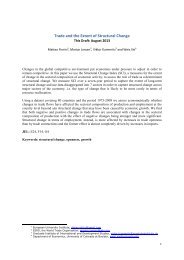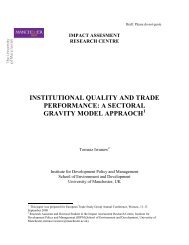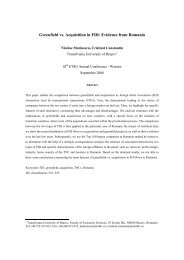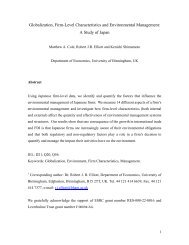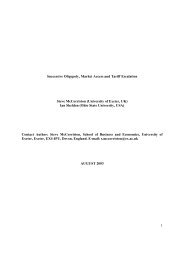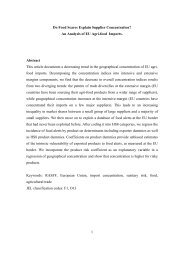Regional integration and the other determinants of North-South ...
Regional integration and the other determinants of North-South ...
Regional integration and the other determinants of North-South ...
Create successful ePaper yourself
Turn your PDF publications into a flip-book with our unique Google optimized e-Paper software.
<strong>the</strong> relevant <strong>determinants</strong> <strong>of</strong> industrial agglomeration by regressing concentration indexes on<br />
"proxy" variables illustrating <strong>the</strong>ories’ forecasts (Kim (1995), Amiti (1999), Haal<strong>and</strong> et al.<br />
(1999), Rosenthal <strong>and</strong> Strange, (2001, 2003)). Haal<strong>and</strong> et al. (1999) show that <strong>the</strong> most<br />
important determinant <strong>of</strong> <strong>the</strong> economic geography <strong>of</strong> Europe is <strong>the</strong> location <strong>of</strong> <strong>the</strong><br />
expenditure, even if <strong>the</strong> Heckscher-Ohlin <strong>and</strong> Ricardo <strong>the</strong>ories should not be ignored. Davis<br />
<strong>and</strong> Weinstein (1999, 2003) also underline <strong>the</strong> significant impact <strong>of</strong> market potential with<br />
regards to location <strong>of</strong> production. More recent papers have analyzed <strong>the</strong> industrial<br />
agglomeration within countries. Considering <strong>the</strong> location choices <strong>of</strong> Japanese firms in<br />
European countries, Head <strong>and</strong> Mayer (2004) confirm that firms prefer to locate “where <strong>the</strong><br />
markets are”. Lu <strong>and</strong> Tao (2009) examine <strong>the</strong> trends <strong>and</strong> <strong>determinants</strong> <strong>of</strong> china’s industrial<br />
agglomeration using a firm-level data set. They confirm <strong>the</strong> impact <strong>of</strong> traditional <strong>determinants</strong><br />
on industrial agglomeration (Marshallian externalities, resource endowments <strong>and</strong> scale<br />
economies). Resmini (2003) <strong>and</strong> Traistaru et al. (2003) have proposed <strong>the</strong> same kind <strong>of</strong> study<br />
considering Central <strong>and</strong> Eastern economies. Brülhart <strong>and</strong> Koening (2005) analyse <strong>the</strong><br />
international spatial wage <strong>and</strong> employment structure <strong>of</strong> five new accession countries 3 during<br />
<strong>the</strong> period 1996-2000. Whereas relative wages <strong>and</strong> employment shares appear still higher in<br />
capital regions, market forces seem to attenuate countries’ economic concentration in favour<br />
<strong>of</strong> regions that are located close to <strong>the</strong> core <strong>of</strong> EU markets. Considering regional <strong>integration</strong><br />
areas, Chen (2008) underlines that because <strong>of</strong> <strong>the</strong> different sizes <strong>of</strong> participating countries,<br />
<strong>the</strong>ir ability to attract investments can be different. Countries with relatively high production<br />
costs may experience a decline in inward FDI while more attractive, low-cost countries could<br />
experience an increase in FDI. Sanguinetti et al. (2004) confirm that <strong>the</strong> increased regional<br />
<strong>integration</strong> in <strong>the</strong> MERCOSUR generates <strong>the</strong> reorganization <strong>of</strong> production along <strong>the</strong> lines <strong>of</strong><br />
internal comparative advantages. With respect to <strong>the</strong> Eastern <strong>and</strong> Sou<strong>the</strong>rn Europe, Altomonte<br />
<strong>and</strong> Gualiano (2003) show that Central <strong>and</strong> Eastern European (CEE) countries seem to<br />
display a greater potential for <strong>the</strong> attraction <strong>of</strong> FDI flows with respect to Mediterranean<br />
countries. The authors explain <strong>the</strong>se results by <strong>the</strong> stronger pecuniary externalities <strong>of</strong> firms in<br />
<strong>the</strong> CEE countries compared to <strong>the</strong> ones existing in Mediterranean countries. Resmini (2003)<br />
underlines that because <strong>of</strong> <strong>the</strong> economic <strong>integration</strong> with <strong>the</strong> EU, firms which are located in<br />
Eastern Europe 4 have begun to shift <strong>the</strong>ir production towards <strong>the</strong> EU border in order to enjoy<br />
relatively low cost access to <strong>the</strong> EU market. Thus, <strong>integration</strong> in Europe is expected to<br />
increase disparities at <strong>the</strong> European level, by generating relocation <strong>of</strong> activities near <strong>the</strong> East-<br />
West frontiers (Petrakos, 2000). These empirical analyses seem to confirm <strong>the</strong> significance <strong>of</strong><br />
both comparative advantages <strong>and</strong> market access in firms’ location choice in <strong>the</strong> case <strong>of</strong><br />
heterogeneous integrated areas.<br />
Many factors thus explain <strong>the</strong> industrial location process in a <strong>North</strong>/<strong>South</strong> regional<br />
area. Comparative advantages can promote <strong>the</strong> dispersion <strong>of</strong> firms when <strong>the</strong> <strong>integration</strong> goes<br />
deeper. Both supply <strong>and</strong> dem<strong>and</strong> accesses have been proven to have a crucial impact on<br />
firms’ location choices <strong>and</strong> encourage <strong>the</strong> location <strong>of</strong> activities in “larger markets”. Strong<br />
input-output links between firms might also generate geographical concentration with <strong>the</strong> fall<br />
<strong>of</strong> trade costs. Finally, <strong>the</strong> spatial distribution <strong>of</strong> activities between countries belonging to a<br />
<strong>North</strong>/<strong>South</strong> regional agreement depends on regional trade barriers, not only between <strong>the</strong><br />
<strong>North</strong> <strong>and</strong> <strong>the</strong> <strong>South</strong> but also between Sou<strong>the</strong>rn countries.<br />
Countries that belong to <strong>the</strong> Euro-Mediterranean area have different development<br />
levels <strong>and</strong> economic characteristics that make <strong>the</strong>ir comparative analysis interesting. The<br />
3 Czech Republic, Hungary, Pol<strong>and</strong>, Slovenia <strong>and</strong> Slovakia.<br />
4 The author analysed <strong>the</strong> impact <strong>of</strong> East enlargement <strong>of</strong> <strong>the</strong> EU on regions in four c<strong>and</strong>idates’ countries<br />
(Bulgaria, Estonia, Hungary <strong>and</strong> Romania) between 1992 <strong>and</strong> 1999.<br />
3


